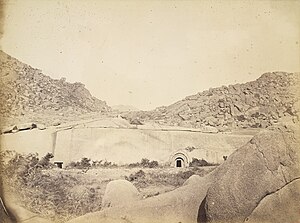
The Marabar Caves are fictional caves which appear in E. M. Forster's 1924 novel A Passage to India and the film of the same name. The caves are based on the real life Barabar Caves, especially the Lomas Rishi Cave, located in the Jehanabad District of Bihar, India which Forster visited during a trip to India.
The caves serve as an important plot location and motif in the story.[1] Key features of the caves are the glass-smooth walls and a peculiar resonant echo amplifying any sound made in the caves. The echo makes the sound “ou-boum” and that sound haunts the characters afterwards. Forster chose the caves to set a turning point in the novel, not just for the character Adela, but also for Mrs Moore, Cyril Fielding and Dr. Aziz: the caves mark a turning point in the novel and their lives. The caves are significant because they mark the hollowness in the lives of the four main characters. None of them are getting what they want and are trying to find a balance in life amid expanding chaos.[2]
- ^ Moran, Jo Ann Hoeppner (1988). "E. M. Forster's a Passage to India: What Really Happened in the Caves". MFS Modern Fiction Studies. 34 (4): 596–604. doi:10.1353/mfs.0.0443. S2CID 162355345.
- ^ Mukherjee, Sujit (1966). "The Marabar Mystery an Addition to the Case-Book on the Caves". College English. 27 (6): 501–503. doi:10.2307/374029. JSTOR 374029.